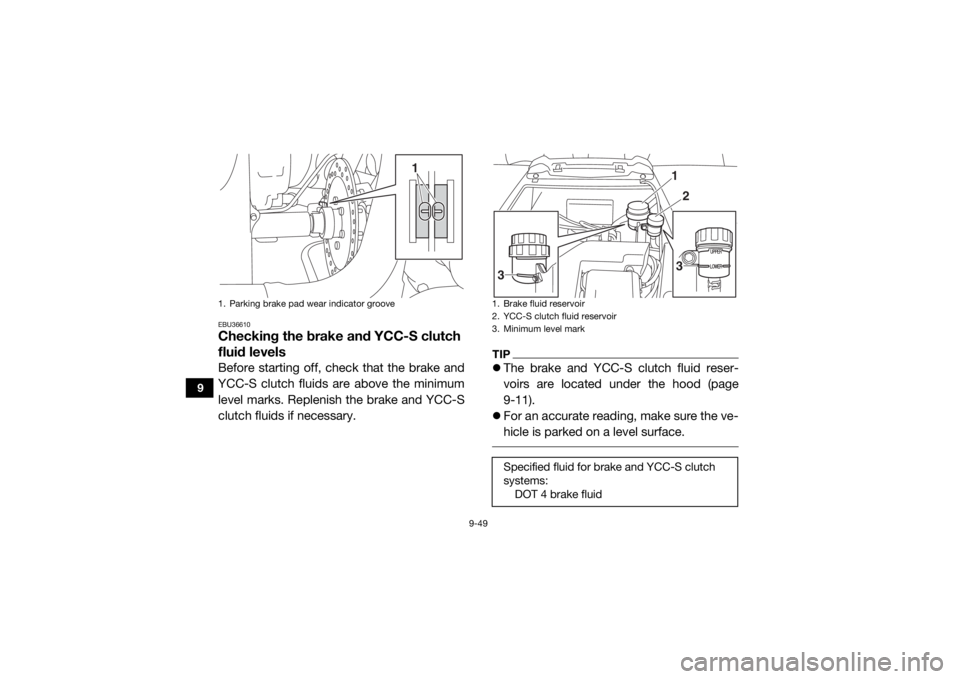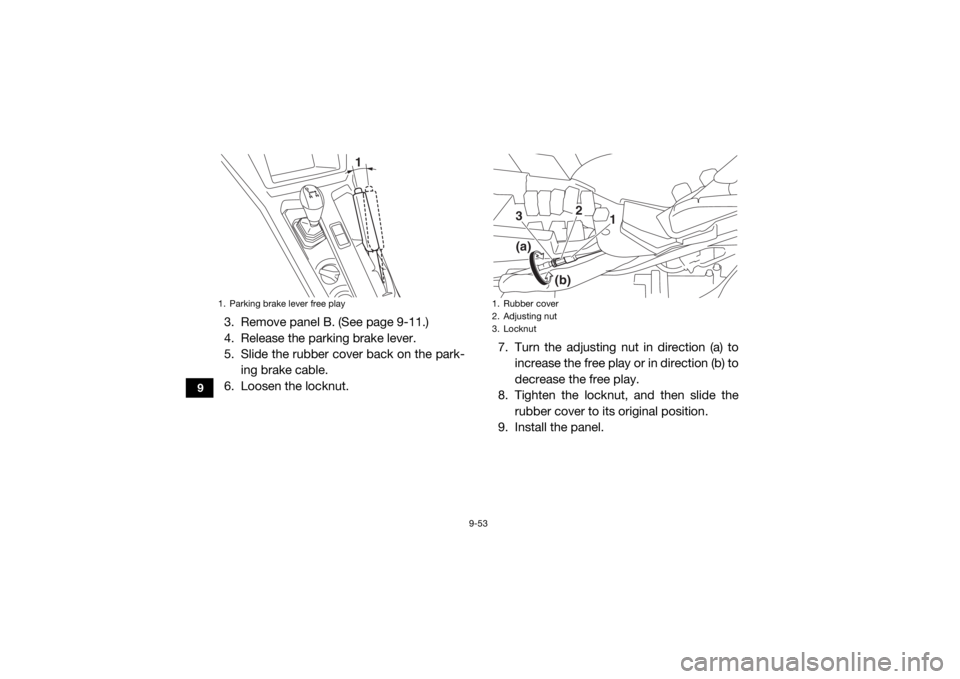YAMAHA YXZ1000R SS 2020 Owners Manual
Manufacturer: YAMAHA, Model Year: 2020, Model line: YXZ1000R SS, Model: YAMAHA YXZ1000R SS 2020Pages: 212, PDF Size: 9.36 MB
Page 171 of 212

9-44
9
6. Wash the foam material in warm soapywater to remove remaining solvent, then
rinse thoroughly with plain warm water.
7. Squeeze out the excess water. NOTICE:
Do not twist the foam material when
squeezing it.
[ECB02970]
8. Allow the foam air filter to dry thoroughly.Inspect for wear and tear and replace if
damaged or heavily worn. 9. Thoroughly apply Yamalube foam air filter
oil (or other quality liquid foam air filter—
do not use a spray-type product) to the
foam material. The foam air filter element
should be wet but not dripping.
10. Pull the foam air filter element over its frame.
11. Install the air filter.
12. Install the air filter case cover and lock it
into place by turning the air filter case
cover lock clockwise.
UBAS7AE0.book Page 44 Wednesday, June 19, 2019 11:51 AM
Page 172 of 212

9-45
9
TIPMake sure that the match mark on the cover
lock is aligned with the close match mark on
the air filter case cover. EBU35130Cleaning the air filter case check hosesThere is a check hose on each side of the air
filter case. If dust or water collects in a check
hose, empty the hose and clean the air filter
element and air filter case.1. Match mark
1
1. Air filter case check hose
1. Air filter case check hose
1
1
UBAS7AE0.book Page 45 Wednesday, June 19, 2019 11:51 AM
Page 173 of 212

9-46
9
EBU35141Cleaning the spark arrester
WARNING
EWB03370Hot exhaust system may cause burns. To
avoid burns or fires, make sure that the en-
gine is stopped and the exhaust system is
cool before cleaning the spark arrester. Do
not start the engine while cleaning the ex-
haust system. 1. Remove the tailpipe cover by removingthe tailpipe cover bolts. 2. Remove the tailpipe bolts.
3. Remove the tailpipe by pulling it out of
the muffler, and then remove the gasket.
4. Tap the tailpipe lightly, and then use a wire brush to remove any carbon depos-
its from the spark arrester portion of the
tailpipe and inside of the tailpipe housing.1. Tailpipe cover
2. Tailpipe cover bolt
1
2
2
1. Tailpipe bolt
1
1
UBAS7AE0.book Page 46 Wednesday, June 19, 2019 11:51 AM
Page 174 of 212

9-47
9
5. Install the gasket, and then insert the tail-pipe into the muffler and align the bolt
holes.
6. Install the tailpipe bolts and tighten them
to the specified torque.
7. Install the tailpipe cover. 8. Install the tailpipe cover bolts and tighten
them to the specified torque.
EBU32460Valve clearanceThe correct valve clearance changes with
use, resulting in improper fuel/air supply or
engine noise. To prevent this, the valve clear-
ance must be adjusted regularly. This adjust-
ment however, should be left to a
professional Yamaha service technician.EBU32470BrakesReplacement of brake components requires
professional knowledge. Brake service
should be performed by a Yamaha dealer.
1. Gasket
2. Spark arrester
3. TailpipeTightening torque:Tailpipe bolt:10 N·m (1.0 kgf·m, 7.4 lb·ft)
2
1
3
Tightening torque:
Tailpipe cover bolt:8 N·m (0.8 kgf·m, 5.9 lb·ft)
UBAS7AE0.book Page 47 Wednesday, June 19, 2019 11:51 AM
Page 175 of 212

9-48
9
WARNING
EWB02572Operating with improperly serviced or ad-
justed brakes could lead to a loss in brak-
ing ability and an accident. EBU35150Checking the front and rear brake padsCheck each brake pad for damage and mea-
sure the lining thickness. If a brake pad is
damaged or if the lining thickness is less than
1.0 mm (0.04 in), have a Yamaha dealer re-
place the brake pads as a set.
The wheels need to be removed to check the
brake pads. (See pages 9-57, 9-59 for wheel
removal and installation procedures.)
EBU32490Checking the parking brake padsEach brake pad is provided with a wear indi-
cator groove, which allows you to check the
brake pad wear without having to disassem-
ble the brake. If a brake pad has worn to the
point that the wear indicator groove has al-
most disappeared, have a Yamaha dealer re-
place the brake pads as a set.1. Lining thickness
1
UBAS7AE0.book Page 48 Wednesday, June 19, 2019 11:51 AM
Page 176 of 212

9-49
9
EBU36610Checking the brake and YCC-S clutch
fluid levelsBefore starting off, check that the brake and
YCC-S clutch fluids are above the minimum
level marks. Replenish the brake and YCC-S
clutch fluids if necessary.
TIPThe brake and YCC-S clutch fluid reser-
voirs are located under the hood (page
9-11).
For an accurate reading, make sure the ve-
hicle is parked on a level surface.
1. Parking brake pad wear indicator groove
1
1. Brake fluid reservoir
2. YCC-S clutch fluid reservoir
3. Minimum level markSpecified fluid for brake and YCC-S clutch
systems:
DOT 4 brake fluid
3
3 12
UBAS7AE0.book Page 49 Wednesday, June 19, 2019 11:51 AM
Page 177 of 212

9-50
9
WARNING
EWB04160Improper maintenance can result in loss of
braking ability or YCC-S clutch operation.
Observe these precautions:
Insufficient brake or YCC-S clutch fluid
may allow air to enter the brake or
YCC-S clutch system, reducing braking
or YCC-S clutch performance.
Clean the filler caps before removing.
Use only DOT 4 brake fluid from a sealed
container.
Use only the specified brake fluid; other-
wise, the rubber seals may deteriorate,
causing leakage.
Refill with the same type of brake fluid.
Adding a brake fluid other than DOT 4
may result in a harmful chemical reac-
tion.
Be careful that water or dust does not
enter the brake or YCC-S clutch fluid
reservoir when refilling. Water will signif-
icantly lower the boiling point of the fluid
and may result in vapor lock.
NOTICEECB01161Brake fluid may damage painted surfaces
or plastic parts. Always clean up spilled
fluid immediately. As the brake pads wear, it is normal for the
brake fluid level to gradually go down. A low
brake fluid level may indicate worn brake
pads or brake system leakage; therefore, be
sure to check the brake pads for wear and the
brake system for leakage. A low YCC-S
clutch fluid level may indicate YCC-S clutch
system leakage; therefore, be sure to check
the YCC-S clutch system for leakage. If the
brake or YCC-S clutch fluid level goes down
UBAS7AE0.book Page 50 Wednesday, June 19, 2019 11:51 AM
Page 178 of 212

9-51
9
suddenly, have a Yamaha dealer check and
repair the vehicle before any further opera-
tion.EBU36550Brake and YCC-S clutch fluid replace-
mentComplete fluid replacement should be done
only by trained Yamaha service personnel.
Have a Yamaha dealer replace the following
components during periodic maintenance or
when they are damaged or leaking.
Replace the oil seals every two years.
Replace the brake and YCC-S clutch hoses
every four years.EBU36540YCC-S clutchThis model is equipped with a hydraulic
clutch, therefore, it is necessary to check the
YCC-S clutch fluid level and check the hy-
draulic system for leak age before each drive.
If the YCC-S clutch plates wear out, shifting
becomes rough or clutch slippage will occur, causing poor acceleration. If any of the above
occurs, have a Yamaha dealer check the
YCC-S clutch.
EBU32531Checking the brake pedalHave a Yamaha dealer check the brakes at
the intervals specified in the periodic mainte-
nance chart. There should be no free play in
the brake pedal. The brakes should operate
smoothly and there should be no brake drag.
If the brakes feel soft or spongy, this could in-
dicate air in the brake system. Have a
Yamaha dealer check the brake system if necessary.
UBAS7AE0.book Page 51 Wednesday, June 19, 2019 11:51 AM
Page 179 of 212

9-52
9
EBU35821Checking the accelerator pedalThe accelerator pedal should operate
smoothly and spring back to position when
released. If the pedal free play is out of spec-
ification, have a Yamaha dealer adjust or re-
place the throttle wire.
EBU35194Parking brake lever free play adjust-
mentPeriodically check the parking brake lever
free play and adjust it if necessary.1. Shift the transmission into first gear.
2. Check the parking brake lever free play.
The maximum free play is equal to one
click of the parking brake lever. If neces-
sary, adjust the free play as follows.
1. Brake pedal
2. No brake pedal free playAccelerator pedal free play:10.0-25.0 mm (0.39-0.98 in)
1
2
1. Accelerator pedal
2. Accelerator pedal free play
2
1
UBAS7AE0.book Page 52 Wednesday, June 19, 2019 11:51 AM
Page 180 of 212

9-53
9
3. Remove panel B. (See page 9-11.)
4. Release the parking brake lever.
5. Slide the rubber cover back on the park-ing brake cable.
6. Loosen the locknut. 7. Turn the adjusting nut in direction (a) to
increase the free play or in direction (b) to
decrease the free play.
8. Tighten the locknut, and then slide the
rubber cover to its original position.
9. Install the panel.1. Parking brake lever free play
1
1. Rubber cover
2. Adjusting nut
3. Locknut
1
(b)
(a)
3
2
UBAS7AE0.book Page 53 Wednesday, June 19, 2019 11:51 AM